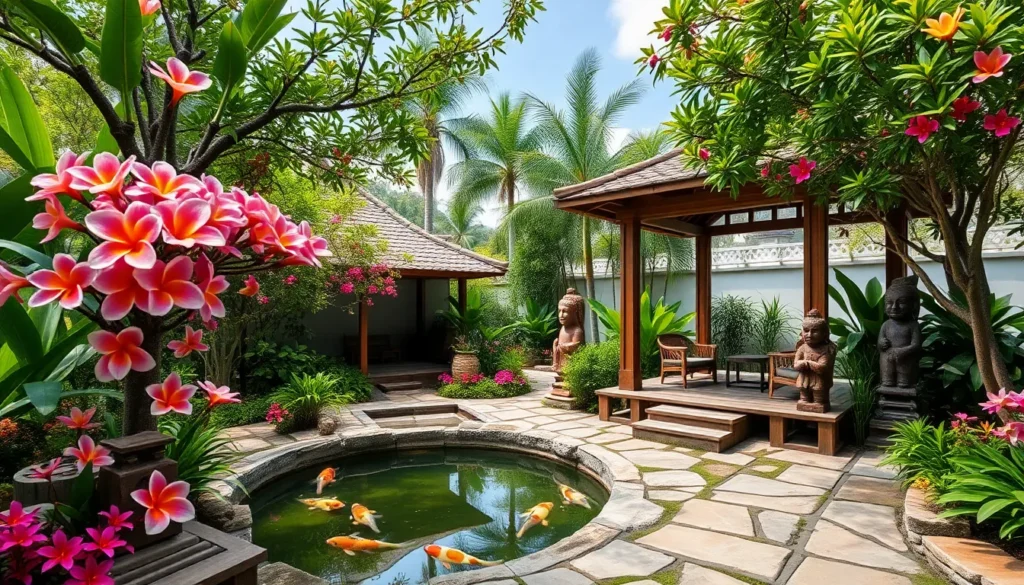We’ve all dreamed of creating that perfect outdoor sanctuary where tropical luxury meets serene tranquility. Balinese garden design offers exactly this – a harmonious blend of lush greenery, natural materials, and spiritual elements that transform any space into your personal paradise.
Drawing inspiration from Indonesia’s enchanting island culture, these gardens emphasize balance between nature and human design. Think cascading water features, aromatic frangipani trees, weathered stone sculptures, and carefully curated plant combinations that create year-round visual interest. The beauty lies in how each element works together to establish a sense of peaceful retreat.
Whether you’re working with a sprawling backyard or a compact urban space, we’ll show you how to incorporate authentic Balinese elements that’ll make your neighbors wonder if you’ve secretly relocated to the tropics. From selecting the right tropical plants to positioning traditional ornaments, these design principles will help you create an outdoor oasis that’s both stunning and spiritually refreshing.
Embrace Natural Stone Elements in Your Balinese Garden Design
Stone elements form the backbone of authentic Balinese garden design, creating a harmonious connection between earth and spirit. We’ll explore how these natural materials can transform your outdoor space into a serene Indonesian-inspired sanctuary.
Incorporate Volcanic Rock Features
Volcanic rocks like paras stone and andesite bring authentic Indonesian character to your Balinese garden design. We recommend using these porous materials for retaining walls, raised planters, and decorative garden sculptures that weather beautifully over time. Local volcanic stone varieties create natural drainage while supporting tropical plants like hibiscus, bird of paradise, and bamboo clusters.
Position large volcanic boulders as focal points near meditation areas or beneath towering palm trees. These statement pieces anchor your garden’s spiritual energy while providing natural seating for quiet contemplation. We suggest placing smaller volcanic rocks around water features to create natural-looking edges that mirror traditional Balinese temple courtyards.
Weathered volcanic stones develop rich patinas and moss growth that enhance your garden’s aged beauty. Stack these materials without mortar to allow plants like creeping ferns and air plants to establish themselves naturally between the crevices.
Add Natural Stone Pathways and Borders
Stone pathways guide visitors through your Balinese garden while defining distinct zones for relaxation and reflection. We prefer using irregularly shaped stepping stones made from local slate, sandstone, or recycled temple stones that create an organic walking experience. Space these stones 18-24 inches apart and surround them with river pebbles, crushed coral, or decomposed granite for authentic texture.
Border your pathways with stacked stone edging using flat river rocks or cut stone blocks. These boundaries separate planting areas from walkways while preventing soil erosion during tropical downpours. We recommend varying the height of stone borders from 6-12 inches to create visual interest and accommodate different plant heights.
Curved pathways lined with natural stone create meandering routes that encourage slow, mindful movement through your garden sanctuary. Install recessed LED lighting beneath pathway stones to illuminate evening strolls while maintaining the mystical ambiance of traditional Balinese temple grounds.
Create Stone Water Features and Fountains
Natural stone water features serve as centerpieces in authentic Balinese garden design, combining the soothing sounds of flowing water with organic textures. We suggest building tiered fountains using stacked volcanic stones, slate slabs, or carved granite bowls that create cascading water effects. These multi-level designs mirror the rice terraces found throughout Bali’s industry.
Carve simple spouts and channels into large stone blocks to direct water flow in controlled patterns. Position these stone fountains near seating areas where the gentle sounds can mask urban noise while promoting meditation and relaxation. We recommend incorporating aquatic plants like water lilies, lotus flowers, and papyrus in stone-lined pools to complete the tropical aesthetic.
Underground stone reservoirs hidden beneath decorative river rocks create recirculating water systems that maintain consistent flow while conserving water. Surround your stone water features with moisture-loving plants such as elephant ears, caladiums, and peace lilies that thrive in the humid microclimate these installations create.
Create Lush Tropical Plant Arrangements
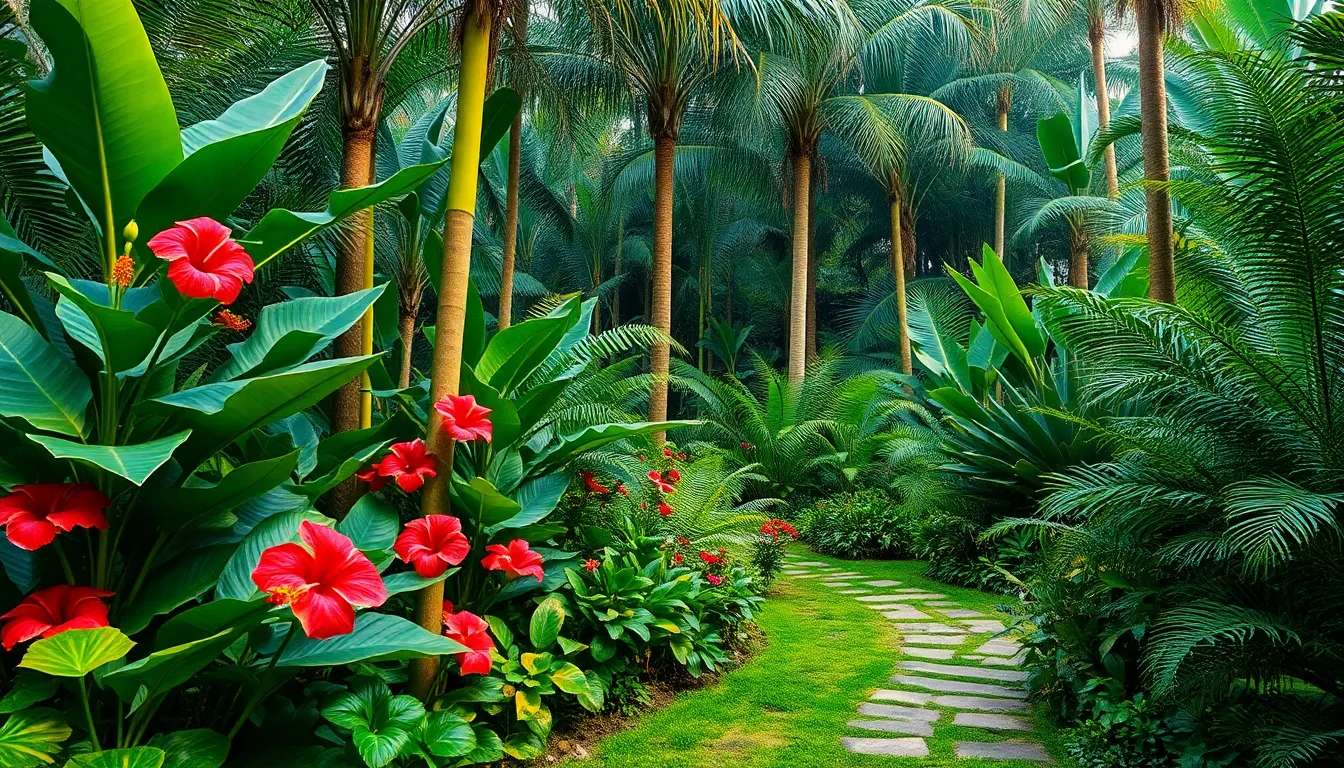
Building upon our foundation of natural stone elements, we’ll now focus on the vibrant plant life that transforms any space into a true Balinese paradise. Dense tropical foliage creates the signature jungle atmosphere that makes these gardens so captivating.
Select Authentic Balinese Flora
Palms form the structural backbone of authentic Balinese gardens, with coconut, Kentia, banana, and bamboo varieties providing elegant architecture and dappled shade throughout the space. We recommend positioning these stately plants strategically to create natural canopies that filter sunlight beautifully.
Ferns add delicate texture in shadier areas where their lacy fronds can thrive without harsh sun exposure. Tree ferns and maidenhair ferns work particularly well beneath palm canopies, creating layers of soft, feathery foliage that dance in gentle breezes.
Bamboo serves dual purposes as both a fast growing screening plant and an authentic cultural element. Choose clumping varieties over running types to maintain control while still achieving that distinctive rustling sound that’s so characteristic of Balinese landscapes.
Frangipani trees become instant focal points with their umbrella shaped canopies and intensely fragrant blooms. These distinctive trees provide welcome shade while filling the air with their sweet, tropical perfume that’s synonymous with Indonesian gardens.
Hibiscus flowers inject vibrant color throughout the season with their bold red, orange, pink, and yellow blooms. Plant these flowering shrubs in clusters to create dramatic color statements that complement the lush green backdrop.
Layer Plants for Dense, Jungle Like Growth
Ground covers establish the foundation of your layered planting scheme, spreading low across the soil to create a lush carpet beneath taller specimens. Select varieties that thrive in partial shade since they’ll be growing under your canopy plants.
Shrubs form the middle tier between ground level plants and towering palms, creating that essential jungle density. We suggest grouping different heights and textures together rather than planting in rigid rows for a more natural appearance.
Tall trees create the upper canopy that provides structure and shade for everything below. Position these larger specimens first when planning your layout, then work downward through the layers to achieve proper spacing and light distribution.
Varying plant heights throughout each section prevents monotonous horizontal lines and creates visual interest from every angle. Mix plants of different mature sizes within each layer to achieve organic, asymmetrical groupings that mimic natural forest growth patterns.
Use Large Leafed Plants as Focal Points
Elephant ear plants command attention with their massive, heart shaped leaves that can reach impressive sizes in optimal growing conditions. Position these dramatic specimens where they can serve as living sculptures within your tropical arrangement.
Philodendron varieties offer diverse leaf shapes and sizes to create multiple focal points throughout the garden space. Split leaf philodendrons work particularly well as statement plants near seating areas or water features.
Strategic placement maximizes visual impact when you position these bold foliage plants at key viewing points along pathways or near gathering spaces. Consider sight lines from both inside your home and various garden locations when choosing placement.
Contrasting textures enhance the drama when large leafed plants are surrounded by finer textured companions like ferns or ornamental grasses. This interplay between bold and delicate creates depth and visual excitement that draws the eye naturally through your Balinese inspired industry.
Install Traditional Water Features for Tranquil Ambiance
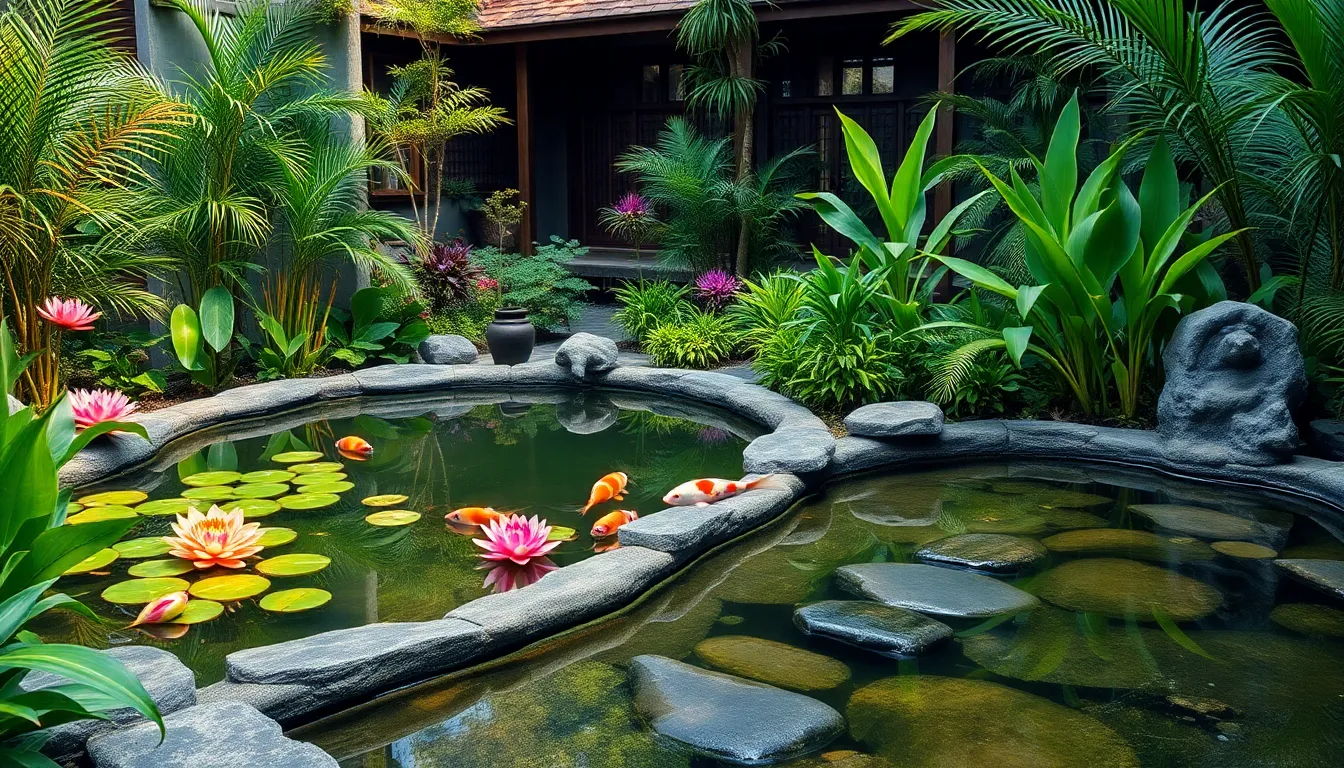
Water features serve as the spiritual heart of any authentic Balinese garden design. These elements transform ordinary outdoor spaces into meditative sanctuaries that capture the essence of Indonesian paradise.
Build a Koi Pond with Natural Edges
Designing a koi pond with natural stone or wood edges creates an organic centerpiece that seamlessly blends with your tropical industry. We recommend using volcanic rock or weathered teak to frame the water’s edge, mimicking the natural formations found in traditional Balinese temple gardens.
Positioning your koi pond near existing plant clusters enhances the jungle-like atmosphere we’ve established with our lush vegetation layers. The colorful koi fish add movement and life to the space while providing a focal point for meditation and contemplation.
Incorporating aquatic plants like water lilies and lotus flowers around the pond’s perimeter completes the authentic Balinese aesthetic. These flowering plants not only provide natural filtration but also attract beneficial wildlife that contributes to your garden’s network.
Add Bamboo Water Spouts and Fountains
Creating bamboo water spouts offers a rustic yet elegant way to introduce the soothing sounds of flowing water throughout your garden sanctuary. We suggest using mature bamboo poles with natural joints to construct traditional-style fountains that complement your existing bamboo plantings.
Installing these water features near seating areas or meditation zones maximizes their calming effects on visitors and residents alike. The gentle trickling sound masks urban noise while creating a peaceful auditory backdrop for relaxation and reflection.
Maintaining bamboo water features requires regular cleaning to prevent algae buildup and ensure optimal water flow. We recommend treating the bamboo with natural sealers to extend its lifespan while preserving the organic appearance that defines authentic Balinese design.
Create Reflecting Pools with Stone Surrounds
Building reflecting pools surrounded by natural stone adds depth and visual interest to your Balinese garden while creating perfect spots for quiet contemplation. We recommend using flat volcanic stones or sandstone to create clean lines that frame the still water surface.
Strategically placing these pools near your stone sculptures or meditation areas amplifies their spiritual significance within the overall garden design. The mirror-like water surface reflects surrounding foliage and sky, creating an illusion of expanded space and enhanced tranquility.
Improving your reflecting pools with subtle underwater lighting extends their beauty into evening hours when soft illumination creates magical reflections. We suggest using warm LED lights positioned beneath natural stone covers to maintain the authentic aesthetic while providing gentle nighttime ambiance.
Design Sacred Spaces with Balinese Spiritual Elements
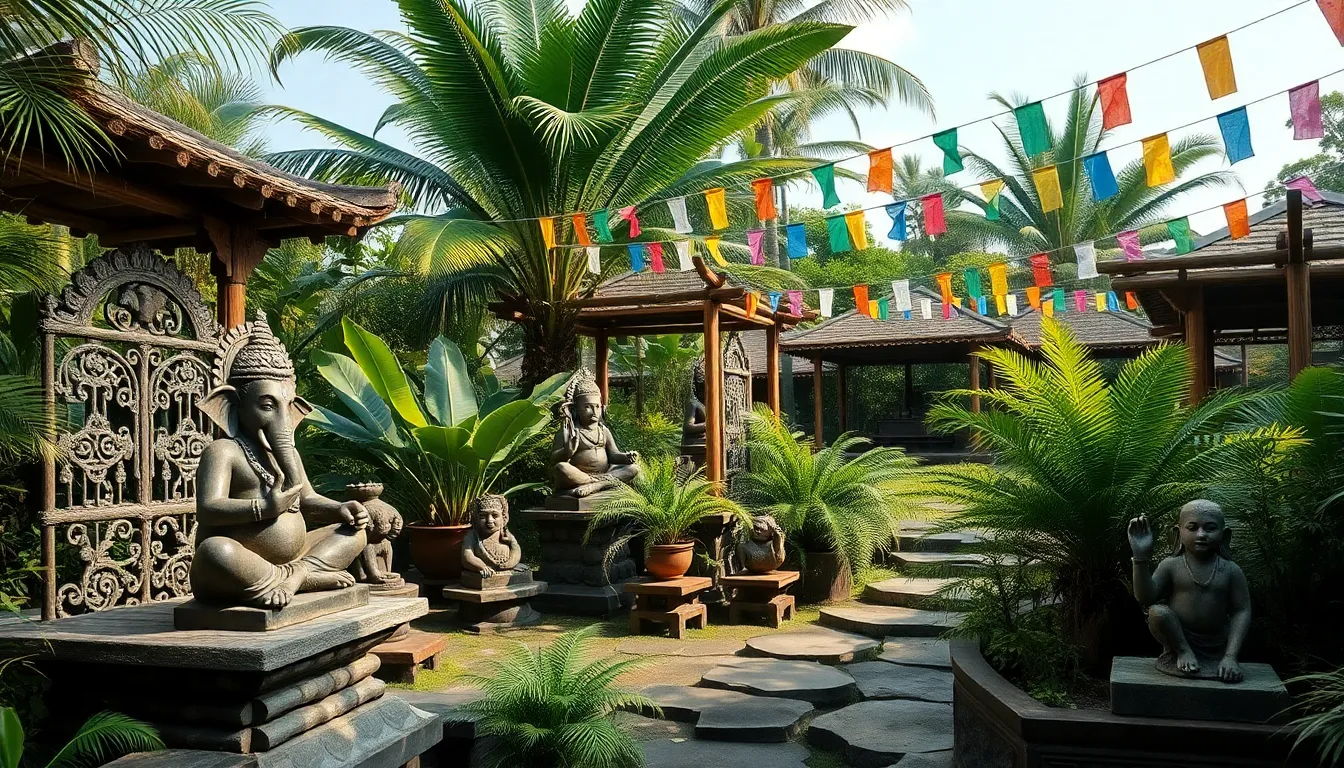
Sacred elements transform ordinary gardens into spiritually rich environments that honor Balinese traditions. We’ll explore how authentic spiritual components create deeper connections between your space and ancient Indonesian culture.
Incorporate Traditional Balinese Statues and Sculptures
Stone deities anchor your garden’s spiritual foundation by representing Hindu and Buddhist traditions central to Balinese culture. We recommend positioning carved Ganesha statues near entrance pathways to symbolize obstacle removal and new beginnings. Temple guardian sculptures work beautifully flanking meditation areas or water features, creating protective energy throughout your space.
Wooden mythical beings add warmth and cultural authenticity to shaded garden corners where stone might feel too formal. Dragons carved from teak or mahogany bring prosperity symbolism while maintaining the natural aesthetic. We suggest placing these sculptures among lush foliage where dappled sunlight can highlight their intricate details.
Animal representations connect your garden to Balinese folklore through meaningful placement and symbolic purpose. Lion statues positioned at garden transitions create powerful focal points that guide visitors between different zones. Elephant sculptures work exceptionally well near water features, symbolizing wisdom and good fortune in traditional Balinese beliefs.
Create Meditation Areas with Natural Materials
Bamboo structures provide the perfect framework for peaceful contemplation spaces that blend seamlessly with tropical surroundings. We recommend constructing simple bamboo pavilions with thatched roofing to create intimate retreat areas. These natural shelters offer protection from sun and rain while maintaining open connections to the garden’s energy.
Volcanic rock foundations ground meditation spaces in authentic Balinese materials that enhance spiritual practice. Circular stone platforms using local volcanic stone create defined meditation zones that feel both ancient and timeless. We suggest adding comfortable cushions in earth tones to soften the stone while maintaining the natural aesthetic.
Lush vegetation encircles meditation areas to create private sanctuaries within larger garden spaces. Dense plantings of ferns, palms, and flowering shrubs form natural walls that provide privacy without feeling enclosed. Strategic placement of fragrant plants like frangipani and jasmine enhances the sensory meditation experience through gentle aromatherapy.
Add Prayer Flags and Wind Chimes
Colorful prayer flags introduce gentle movement and spiritual symbolism throughout your Balinese garden design. We recommend stringing traditional Buddhist prayer flags between bamboo poles or tree branches to create visual interest and cultural depth. These fabric elements flutter in tropical breezes, symbolizing the spreading of positive intentions across your outdoor sanctuary.
Wind chimes provide soothing soundscapes that complement water features and enhance the garden’s peaceful ambiance. Bamboo wind chimes produce softer, more natural tones that harmonize with rustling palm fronds and flowing water. We suggest positioning multiple chimes at varying heights to create layered sound experiences throughout different garden zones.
Strategic placement maximizes spiritual impact while maintaining visual balance within your overall garden design. Corner installations where paths intersect create natural gathering points for contemplation and reflection. We recommend avoiding overcrowding by limiting flags and chimes to key focal areas where they can provide maximum spiritual enhancement without overwhelming the space.
Integrate Natural Bamboo Structures Throughout
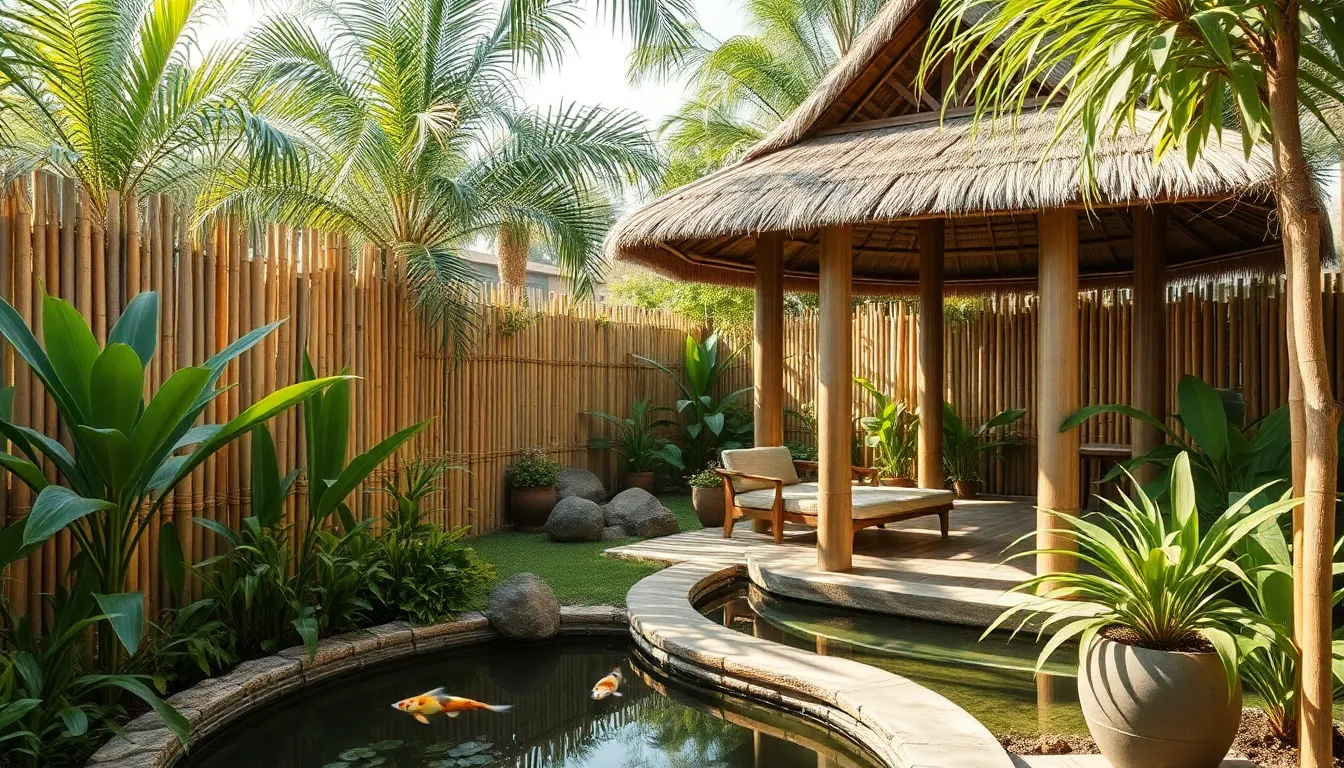
Bamboo serves as the backbone of authentic Balinese garden design, creating seamless transitions between different garden zones while maintaining the tropical aesthetic we’ve established with our stone elements and lush plantings.
Build Bamboo Fencing and Privacy Screens
Bamboo fencing creates natural barriers that provide privacy without sacrificing the open, tropical feel essential to Balinese design. We recommend installing vertical bamboo poles with horizontal supports to form traditional screening that blocks unwanted views while allowing gentle breezes to flow through your sanctuary.
Privacy screens made from bamboo work exceptionally well around meditation areas and koi ponds, creating intimate spaces within larger garden layouts. These screens can be positioned strategically to separate different functional zones like dining areas from water features or sacred spaces from entertainment zones.
Natural bamboo panels offer flexibility in design, allowing us to create curved screens that follow organic pathways or straight barriers that define clean garden borders. The golden color of aged bamboo complements the volcanic stone elements and vibrant tropical foliage we’ve previously incorporated.
Construct Bamboo Gazebos and Pavilions
Bamboo gazebos provide perfect focal points for relaxation while blending seamlessly with the surrounding tropical industry. We suggest building octagonal or circular structures using thick bamboo poles for support beams, creating cozy spots that overlook water features or frame mountain views.
Pavilions constructed from bamboo serve multiple purposes in Balinese gardens, functioning as meditation retreats, dining areas, or social gathering spaces. These larger structures typically feature raised floors and thatched roofs, providing shelter while maintaining connection to the natural environment.
Traditional bamboo construction techniques involve lashing joints with natural rope or wire, creating flexible structures that move gently with wind rather than fighting against natural forces. This approach aligns perfectly with Balinese philosophy of working harmoniously with nature rather than dominating it.
Use Bamboo Planters and Garden Borders
Bamboo planters add vertical growing space while maintaining the natural aesthetic we’ve cultivated throughout our garden design. We can create these containers using split bamboo sections or woven bamboo panels, perfect for showcasing orchids, bromeliads, and other epiphytic plants common in Balinese landscapes.
Garden borders made from bamboo help define planting beds and pathways while providing clean visual separation between different garden zones. These borders work especially well around the base of palm trees or to contain ground cover plants that might otherwise spread beyond intended areas.
Raised bamboo planters create opportunities for layered planting designs, allowing us to establish different growing conditions within the same garden space. We can fill these elevated containers with specialized soil mixes for exact plants like air plants or moisture loving ferns that complement our existing stone and water features.
Establish Outdoor Living Areas with Balinese Flair
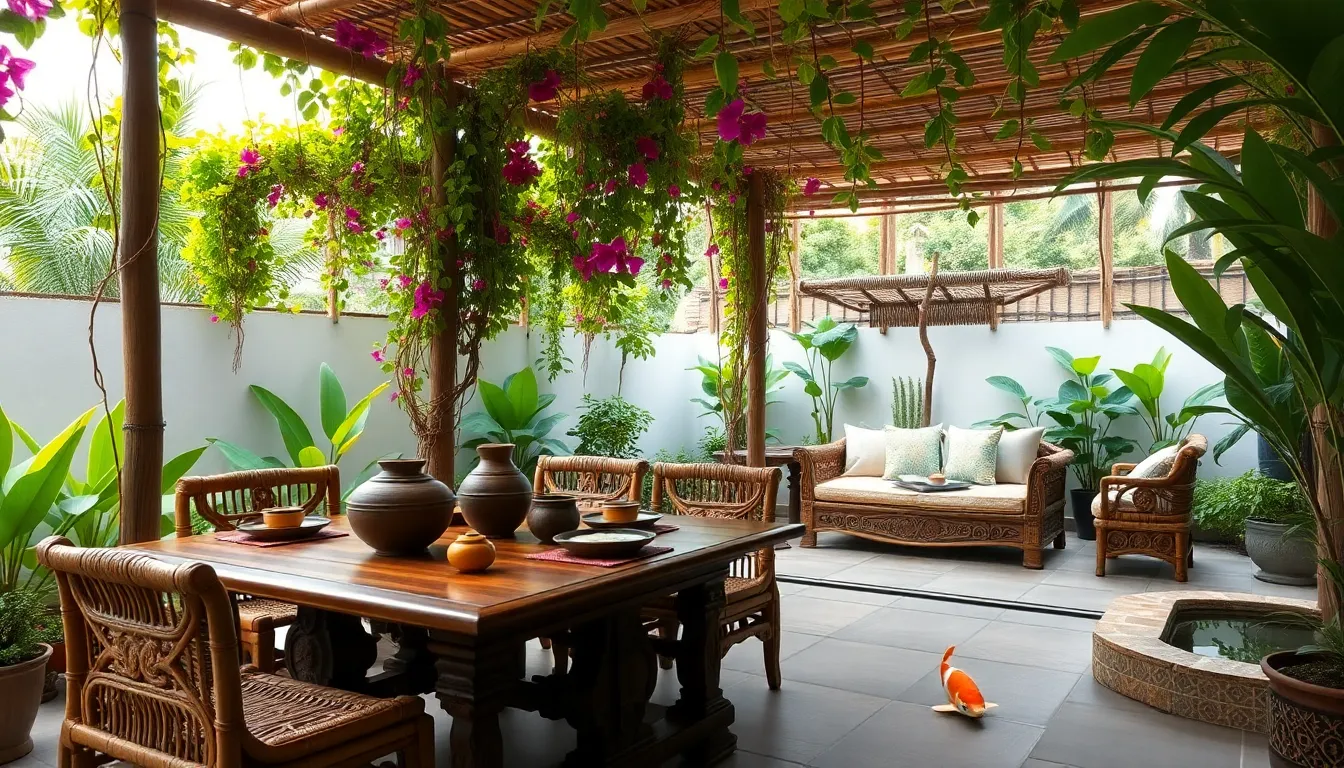
Creating functional spaces that blend traditional Indonesian aesthetics with modern comfort transforms your garden into a true tropical sanctuary. These outdoor areas serve as extensions of your indoor living space while maintaining authentic Balinese design principles.
Design Covered Seating Areas with Natural Materials
Bamboo structures form the foundation of authentic Balinese seating areas, providing both shelter and visual appeal. We recommend incorporating natural bamboo poles to create pergola-style coverings that support climbing plants like jasmine and bougainvillea. Traditional woven bamboo panels work perfectly as privacy screens, offering intimacy while maintaining the tropical aesthetic.
Wood selection plays a crucial role in achieving that genuine Indonesian feel throughout your covered spaces. Teak and mahogany create durable furniture pieces that weather beautifully in outdoor environments. Carved wooden benches and low-profile seating arrangements encourage relaxation while staying true to Balinese design traditions.
Stone accents enhance the spiritual atmosphere that defines authentic Balinese gardens. Position volcanic rock sculptures and carved deity statues around seating areas to create focal points for meditation and contemplation. Natural stone platforms serve as bases for seating, connecting your covered areas to the earth in meaningful ways.
Create Outdoor Dining Spaces Under Pergolas
Pergola construction using natural materials establishes the perfect framework for memorable outdoor dining experiences. We suggest building structures with bamboo or weathered wood beams that support tropical vines and flowering plants. These organic canopies provide shade while creating intimate dining environments that feel connected to nature.
Furniture arrangements should prioritize low-profile pieces that encourage communal gathering and conversation. Wooden dining tables paired with rattan chairs maintain the natural aesthetic while providing comfortable seating for family meals. Traditional Indonesian serving pieces and bamboo placemats complete the authentic dining atmosphere.
Lighting answers transform pergola dining areas into magical evening destinations that extend your garden enjoyment. Mason jar lanterns filled with natural materials like stones and twigs create warm, ambient lighting throughout the space. String lights woven through pergola beams add gentle illumination without disrupting the natural harmony.
Add Daybed Areas for Relaxation
Secluded placement ensures your daybed areas become true retreats within the larger garden industry. We recommend positioning these relaxation zones behind lush plantings of elephant ear and philodendron, creating private sanctuaries surrounded by tropical foliage. Natural stone pathways guide visitors to these hidden gems while maintaining the garden’s mysterious appeal.
Material choices for daybeds should reflect traditional Balinese craftsmanship and durability in outdoor settings. Teak frames with weather-resistant cushions provide comfort while honoring Indonesian woodworking traditions. Rattan and woven bamboo details add texture and authenticity to these essential relaxation features.
Water proximity enhances the calming effects of daybed areas by incorporating the soothing sounds of flowing water. Position daybeds near bamboo fountains or reflecting pools to create multi-sensory relaxation experiences. Small ponds with koi fish and lotus flowers provide natural entertainment while deepening the connection to traditional Balinese garden elements.
Incorporate Traditional Balinese Garden Accessories
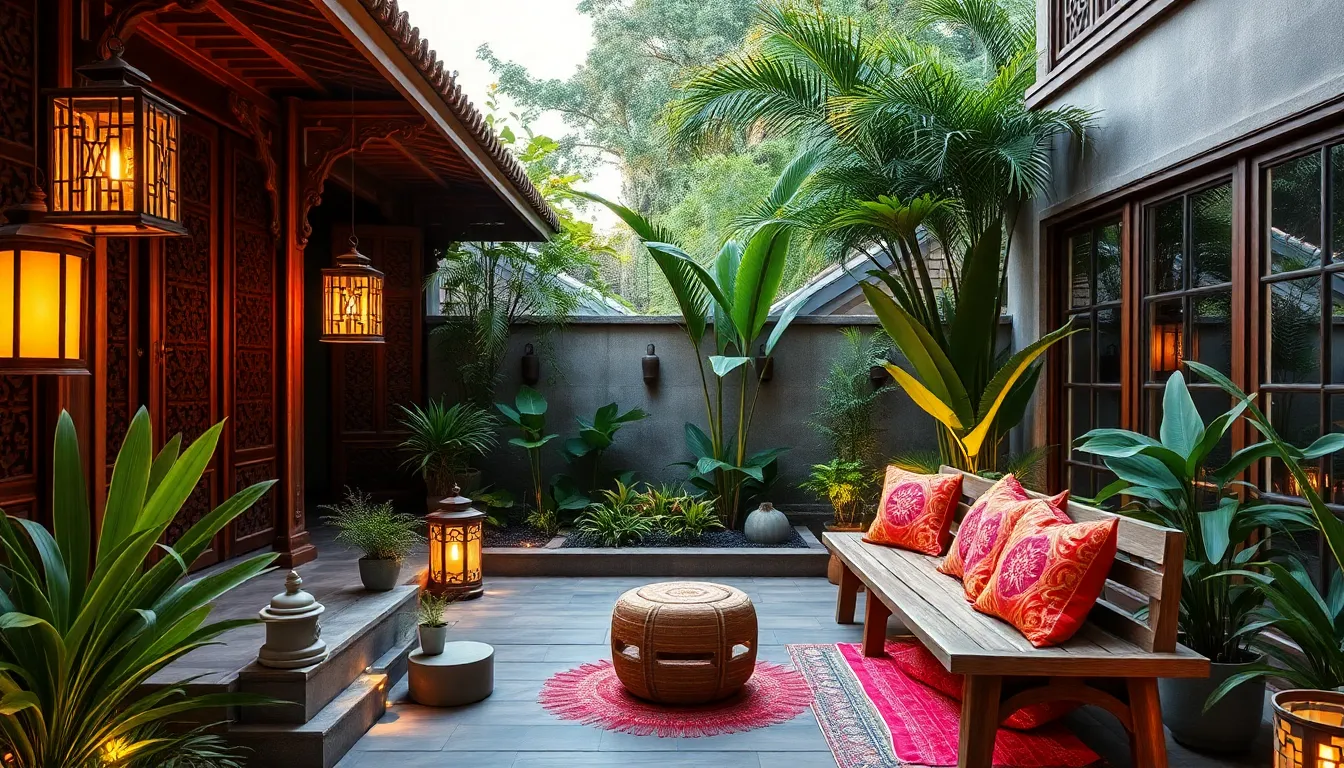
We’ll now explore the essential accessories that complete our Balinese garden transformation and add authentic Indonesian charm to every corner.
Use Carved Wooden Elements and Decor
Carved wooden elements serve as the artistic backbone of our traditional Balinese garden design. We recommend selecting pieces crafted from tropical hardwoods like teak or mahogany, which naturally resist weather damage while developing beautiful patinas over time. Garden gates adorned with intricate floral motifs or mythological creatures create stunning entrances that immediately transport visitors to Indonesian temples.
Decorative wooden panels work exceptionally well as privacy screens between different garden zones, featuring traditional patterns like lotus flowers, tropical vines, and geometric designs. We suggest incorporating carved wooden planters shaped like elephants, birds, or traditional urns to showcase our tropical plants while maintaining cultural authenticity.
Furniture pieces such as low wooden benches with detailed carvings provide comfortable seating areas that blend seamlessly with the natural environment. Carved wooden sculptures depicting Balinese dancers, temple guardians, or wildlife add focal points throughout the garden that celebrate Indonesian artistry and craftsmanship.
Add Traditional Balinese Lanterns and Lighting
Traditional Balinese lanterns transform our garden spaces into magical evening retreats filled with warm, golden illumination. We recommend using bamboo lanterns with intricate cut out patterns that cast beautiful shadows on surrounding plants and walkways when lit with LED candles or solar lights.
Stone lanterns carved from volcanic rock provide permanent lighting fixtures that complement our natural stone features while maintaining weather resistance throughout the seasons. We suggest placing these lanterns along pathways, near water features, and around seating areas to create a cohesive lighting scheme that guides movement and highlights key garden elements.
Hanging lanterns made from natural materials like rattan or woven palm fronds add vertical interest when suspended from bamboo pergolas or tree branches. Solar powered options ensure our lighting remains environmentally friendly while providing consistent illumination without electrical installation requirements.
Paper lanterns in warm colors like orange, red, and gold create festive atmospheres for special occasions while remaining true to traditional Indonesian celebrations and ceremonies.
Include Handwoven Textiles and Cushions
Handwoven textiles bring vibrant colors and cultural authenticity to our outdoor seating areas while providing comfort for relaxation and meditation. We recommend selecting weather resistant fabrics featuring traditional Indonesian patterns such as batik designs, geometric motifs, or tropical flora in earth tones that complement our natural garden palette.
Cushions made from quick drying materials ensure our seating remains comfortable even after tropical rain showers, while removable covers allow for easy cleaning and seasonal updates. We suggest mixing different sizes and patterns to create ever-changing seating arrangements on our wooden benches, daybed areas, and meditation spaces.
Outdoor rugs woven from natural fibers like jute or bamboo define our gathering spaces while adding texture beneath dining areas and conversation zones. Traditional Indonesian textiles featuring gold thread accents catch sunlight during the day and create elegant reflections under evening lantern light.
Throw pillows in jewel tones like emerald green, sapphire blue, and ruby red provide pops of color that echo the vibrant tropical flowers throughout our garden while maintaining the rich, luxurious feel characteristic of authentic Balinese design.
Plan Meandering Pathways Through Your Garden
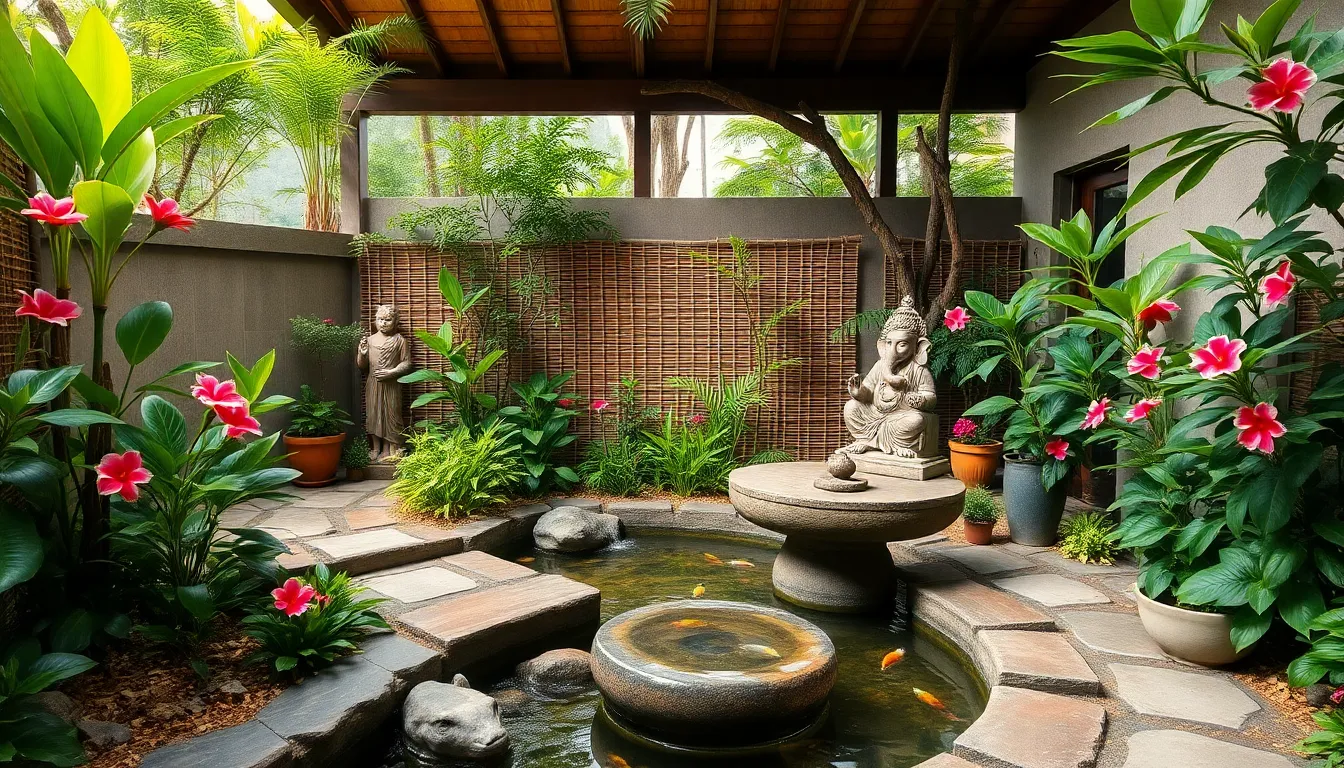
Well-designed pathways transform your Balinese garden into an immersive experience that invites exploration and discovery. We’ll guide you through creating authentic Indonesian-style walkways that enhance your outdoor sanctuary’s natural flow.
Create Curved Walkways with Natural Materials
Curved pathways mirror the organic flow found in traditional Balinese landscapes, creating visual interest while encouraging visitors to slow down and appreciate each garden element. We recommend using weathered teak planks, volcanic stone slabs, or bamboo decking to construct these winding routes through your tropical paradise.
Natural materials like rough-hewn volcanic rock create authentic texture underfoot while blending seamlessly with your existing stone water features and meditation areas. Bamboo stepping platforms work beautifully when elevated slightly above ground level, allowing water to flow beneath during heavy rains while maintaining the organic aesthetic.
Varying the pathway width creates ever-changing visual appeal as visitors move from narrow passages through dense frangipani groves to wider areas that open up near your koi ponds. We suggest incorporating gentle curves that follow the natural contours of your industry rather than forcing straight lines through your tropical plantings.
Add Stepping Stones Across Water Features
Stepping stones across your water features create magical moments of connection between different garden zones while honoring traditional Balinese design principles. We recommend using flat volcanic rocks or carved stone slabs positioned at comfortable walking intervals above your reflecting pools and koi ponds.
Strategic placement allows visitors to pause mid-crossing and observe the colorful fish below or appreciate water lily blooms at eye level. Natural stone selections should complement your existing meditation area materials while providing stable, non-slip surfaces for safe passage.
Bamboo platforms can serve as alternative stepping answers, especially when combined with traditional joinery techniques that eliminate metal fasteners. We suggest positioning these elements to create contemplative pauses where visitors can enjoy the soothing sounds of your bamboo water spouts and fountains.
Design Hidden Garden Nooks and Discoveries
Hidden alcoves throughout your meandering pathways create intimate spaces for quiet reflection while maintaining the sense of exploration that defines authentic Balinese gardens. We recommend tucking small meditation spots behind dense plantings of elephant ear and philodendron, accessed only by narrow stone or bamboo walkways.
Sacred elements like carved Ganesha statues or temple guardian figures work perfectly as focal points for these secluded areas, surrounded by fragrant hibiscus flowers and prayer flags that flutter gently in tropical breezes. Privacy screens made from woven bamboo or traditional wooden panels enhance the sense of discovery while maintaining visual connections to your main garden areas.
Surprise elements along your pathways might include small water features trickling into moss-covered volcanic rock basins or daybed alcoves positioned to capture morning light filtering through your palm canopy. We suggest varying the scale of these discoveries, from intimate single-person meditation spots to larger family gathering areas that celebrate the communal spirit of Indonesian culture.
Conclusion
Creating your own Balinese garden sanctuary brings together all these authentic elements to form a cohesive tropical paradise. We’ve shown you how natural materials bamboo stone wood and carefully selected plants work together to establish the foundation of this peaceful retreat.
The spiritual elements sacred statues and traditional accessories we’ve discussed add cultural depth while maintaining the serene atmosphere that makes Balinese gardens so captivating. Your outdoor space becomes more than just a garden – it transforms into a living meditation sanctuary.
Remember that successful Balinese garden design isn’t about perfection but about creating harmony between all elements. Start with one or two key features and gradually build your tropical oasis as your vision develops and your space evolves.
Frequently Asked Questions
What are the key elements of a Balinese garden design?
Balinese garden design features lush tropical vegetation, natural stone elements (especially volcanic rock), traditional water features like koi ponds and bamboo fountains, sacred sculptures and statues, bamboo structures, and meandering pathways. These elements work together to create a balanced, spiritually rich outdoor sanctuary that promotes tranquility and connection with nature.
What types of plants are essential for an authentic Balinese garden?
Essential Balinese plants include palms, ferns, bamboo, frangipani trees, hibiscus flowers, elephant ear plants, and philodendron. Layer these plants with ground covers, shrubs, and tall trees to create a dense jungle-like atmosphere. Large-leafed tropical plants serve as stunning focal points throughout the garden.
How do water features enhance a Balinese garden?
Water features serve as the spiritual heart of Balinese gardens. Koi ponds with natural stone edges create organic centerpieces, while bamboo spouts and fountains provide soothing sounds. Reflecting pools add depth and tranquility, especially with subtle underwater lighting. These features promote relaxation and enhance the tropical atmosphere.
What sacred elements should be included in a Balinese garden?
Traditional Balinese statues like carved Ganesha and temple guardians anchor the garden’s spiritual foundation. Wooden mythical beings connect to Balinese folklore, while meditation areas with natural materials provide contemplation spaces. Prayer flags and wind chimes add movement and sound, enhancing the peaceful, culturally authentic ambiance.
How can bamboo be incorporated into Balinese garden design?
Bamboo creates natural transitions between garden zones through fencing and privacy screens. Build bamboo gazebos and pavilions as relaxation focal points using traditional construction techniques. Use bamboo planters and borders to define spaces and add vertical growing areas while maintaining the authentic tropical aesthetic.
What accessories complete an authentic Balinese garden?
Essential accessories include carved wooden gates and decorative panels made from tropical hardwoods like teak or mahogany. Traditional Balinese lanterns create magical evening lighting, while handwoven textiles and colorful cushions enhance outdoor seating comfort. These elements add authentic Indonesian charm and cultural richness to the garden.
How should pathways be designed in a Balinese garden?
Create curved, meandering walkways using natural materials like weathered teak, volcanic stone, or bamboo. Vary pathway widths for visual interest and incorporate stepping stones across water features. Design hidden garden nooks with meditation spots and sacred elements in secluded areas to encourage exploration and quiet reflection.

